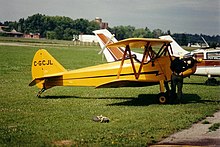
The Ace Baby Ace, a single-seat, single-engine, parasol wing, fixed-gear light airplane, was marketed as a homebuilt aircraft when its plans were first offered for sale in 1929 — one of the first homebuilt aircraft plans available in the United States. Plans are still available and Baby Aces are still being built. Orland Corben designed a series of aircraft for the Ace Aircraft Manufacturing Company, the Baby Ace, Junior Ace, and Super Ace. Corben's name was associated with the aircraft, and it is commonly known as the Corben Baby Ace.

The Pietenpol Air Camper is a simple parasol wing homebuilt aircraft designed by Bernard H. Pietenpol. The first prototype that became the Air Camper was built and flown by Pietenpol in 1928.

The Canadian Aviation Regulations define two types of ultralight aircraft: basic ultra-light aeroplane (BULA), and advanced ultra-light aeroplane (AULA).

The Progressive Aerodyne SeaRey is an American two-seat, single-engine, amphibious flying boat designed and manufactured by Progressive Aerodyne originally in Orlando, Florida, and now in Tavares, Florida. It was first flown in November 1992 and is sold as a kit aircraft for amateur construction as well as a light-sport aircraft.
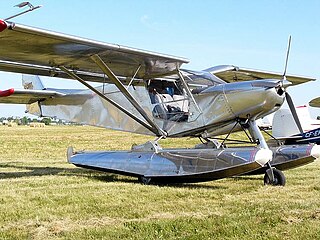
The Zenith STOL CH 701 and CH 750 are a family of light, two-place kit-built STOL aircraft designed by Canadian aeronautical engineer Chris Heintz through his Midland, Ontario, based company, Zenair. The CH 701 first flew in 1986 and the design is still in production. The CH 750 was first introduced in 2008. The CH 701 was later developed into the four-place Zenith STOL CH 801.
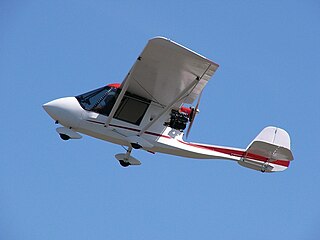
The Quad City Challenger is a family of one and two seats-in-tandem, pusher configuration, tricycle landing gear ultralight aircraft that is designed and produced by Quad City Aircraft Corporation of Moline, Illinois. The Challenger was first introduced in 1983.

The Goupy No.2 was an experimental aircraft designed by Ambroise Goupy and Mario Calderara and built in France in 1909 at the Blériot factory at Buc. The Goupy No.2 is significant for two major and influential innovations in aircraft design: it was the first tractor configuration biplane to fly and the first biplane to feature staggered wings, built with a landing gear configuration nearly identical in appearance to the Blériot XI monoplane, flown earlier that year. While both these features would very soon become the norm in aircraft design, the No.2 was described in the aviation press at the time as having a "somewhat unusual design". The only features that would not be typical of aircraft in the years to come would be its biplane tail unit, and the whole-chord wingtip ailerons fitted to both upper and lower wings. The uncovered wood box-girder fuselage, typical of early aircraft, was later covered.

The Avro 562 Avis was a two-seat light biplane designed and built by the A.V.Roe and Company Limited at Hamble for the 1924 Lympne Light Aeroplane Trials.
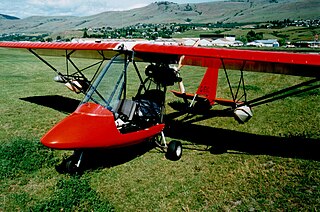
The Spectrum Beaver is a family of single- and two-place, pusher configuration, high-wing ultralight aircraft that were designed by Larry Croome and first introduced by Spectrum Aircraft of Surrey, British Columbia, Canada, in 1983.

The Fisher Celebrity is a Canadian two-seat, conventional landing gear, single engined, biplane kit aircraft designed for construction by amateur builders. Fisher Flying Products was originally based in Edgeley, North Dakota, United States but the company is now located in Dorchester, Ontario, Canada.

The Murphy JDM-8 is a Canadian single-seat ultralight monoplane designed by Daryl Murphy. The type was intended to be sold as a kit for home construction by Murphy Aircraft of Chilliwack, British Columbia.
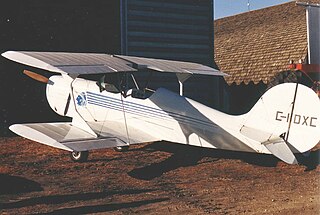
The Murphy Renegade is a family of Canadian two-seats-in-tandem, single engine, conventional landing gear, biplanes, produced by Murphy Aircraft and intended for amateur construction.
The Excalibur is an American two seats-in-tandem, high wing, pusher configuration ultralight aircraft that is manufactured in kit form for amateur construction, by Excalibur Aircraft of Sebring, Florida. It was introduced in 1993.

The Smith DSA-1 Miniplane is a single-seat, single-engine sport aircraft designed in the United States in the 1950s and marketed for home building.

The Direct Fly Alto is a Czech ultralight and light-sport aircraft, designed and produced by Direct Fly sro of Hluk. The aircraft is supplied as a standard or quick-build kit for amateur construction or as a complete ready-to-fly-aircraft.
The Acrolite is a family of Canadian amateur-built aircraft, designed by Ron Wilson and produced by Acrolite Aircraft of Kakabeka Falls, Ontario, in the form of plans for amateur construction.

The Platzer Motte is a German amateur-built aircraft designed by Michael Platzer and made available in the form of plans for amateur construction.

The Hummel Ultracruiser is an American amateur-built aircraft, designed by Morry Hummel and produced by Hummel Aviation. The aircraft is supplied as a kit or plans for amateur construction or as a complete ready-to-fly aircraft.
The Pegna-Bonmartini Rondine, or Pegna Rondine, is a single-seat ultralight sport aeroplane designed by Giovanni Pegna and built by Piaggio in Italy during 1923.
The Bilsam Sky Cruiser is a Polish microlight aircraft designed and produced by Bilsam Aviation of Poznań, introduced in the early 2000s. The aircraft is supplied as a complete ready-to-fly-aircraft, as a kit and in the form of plans for amateur construction.


